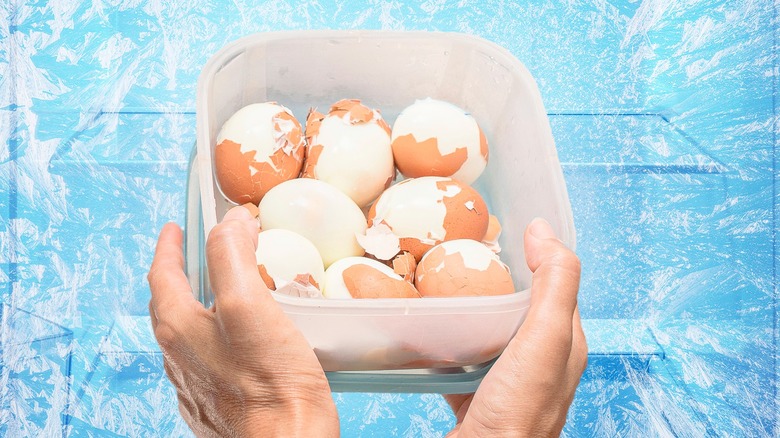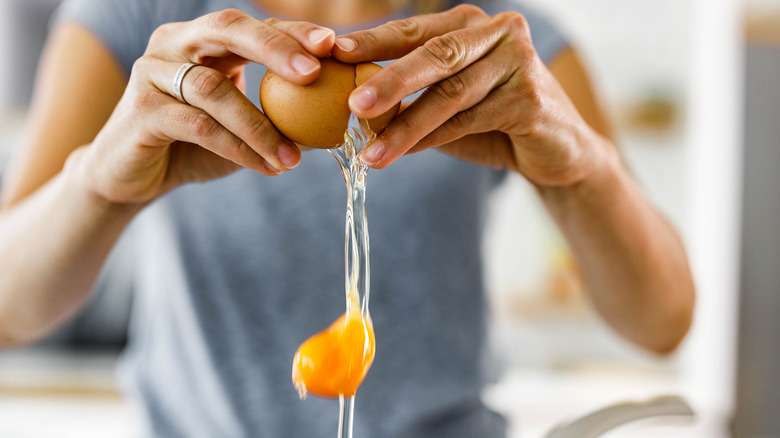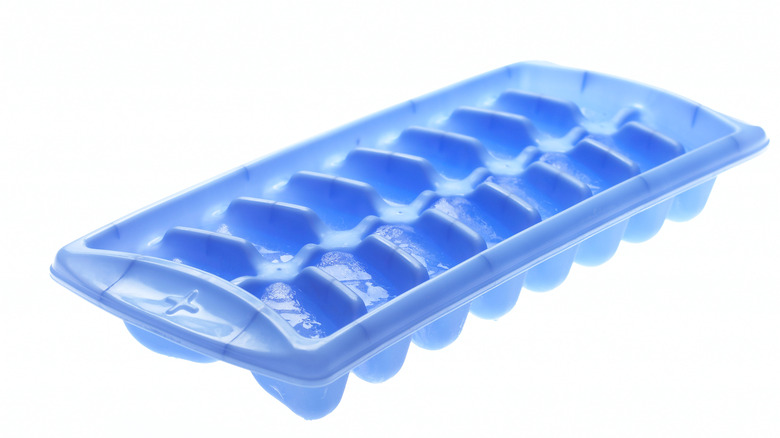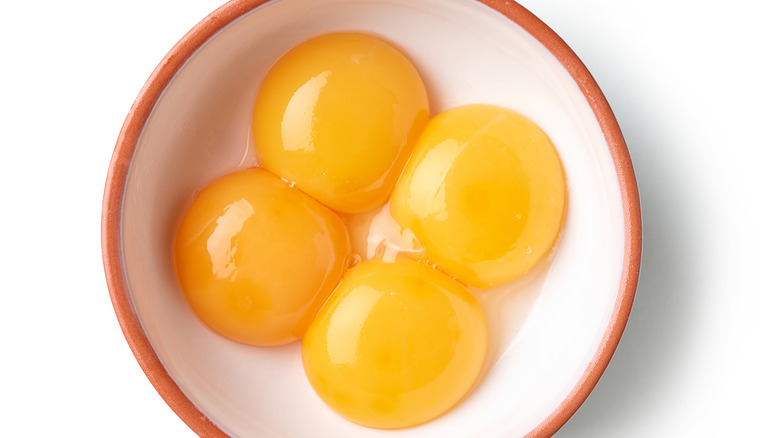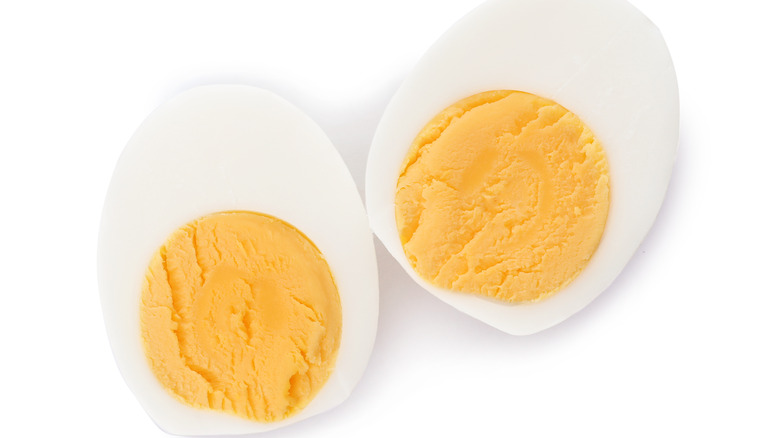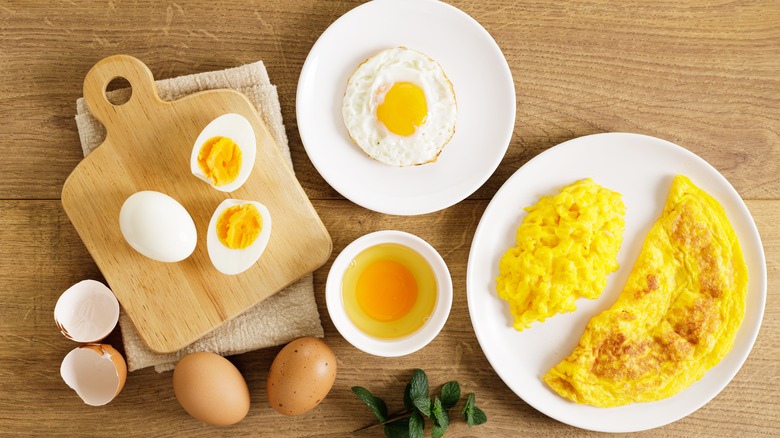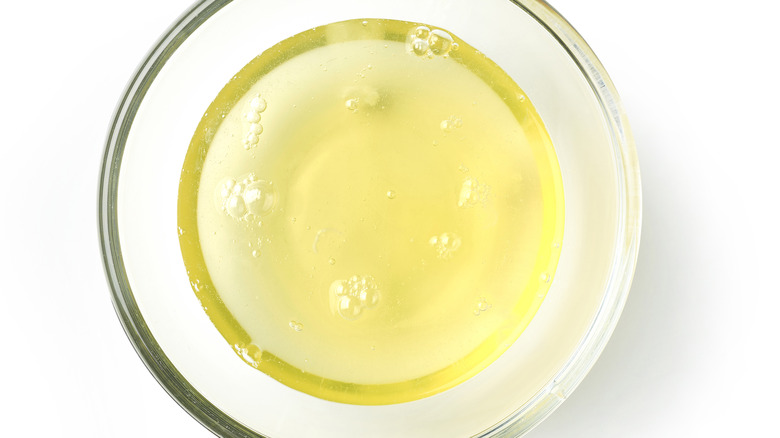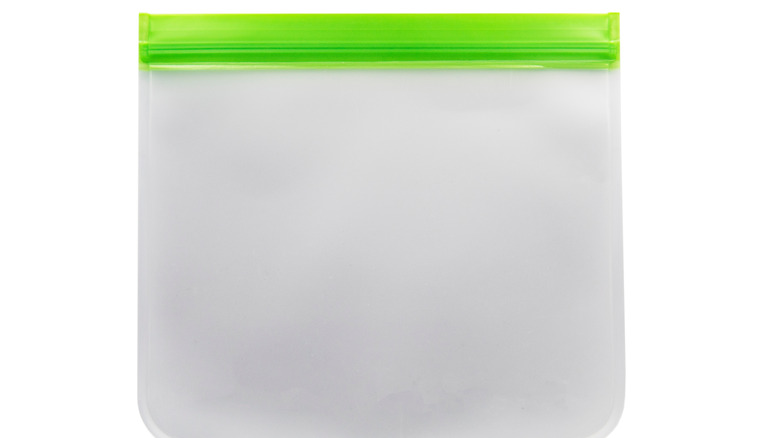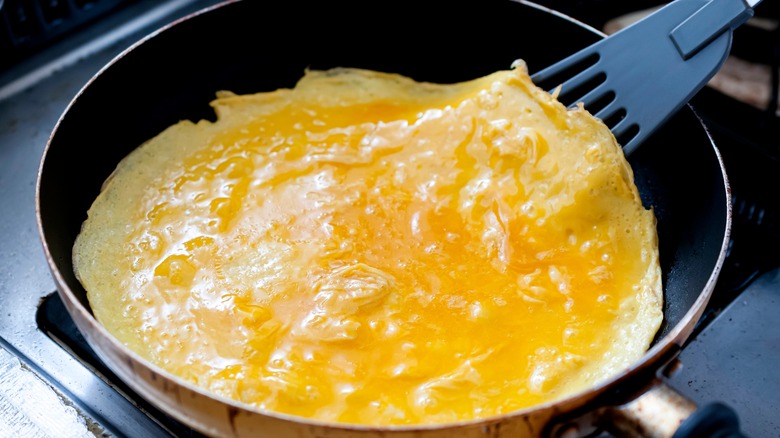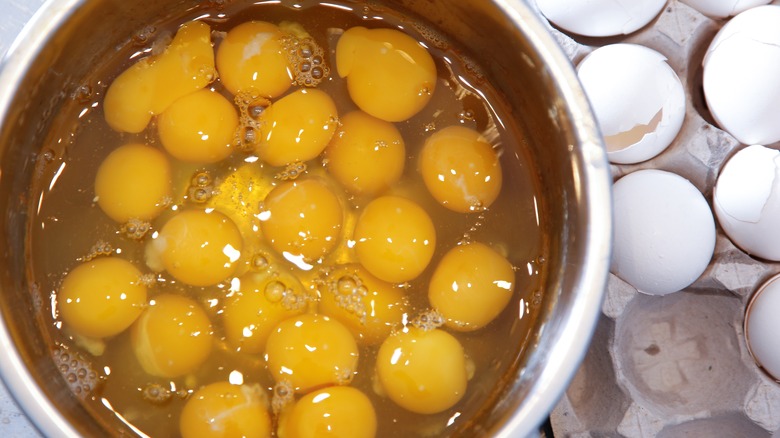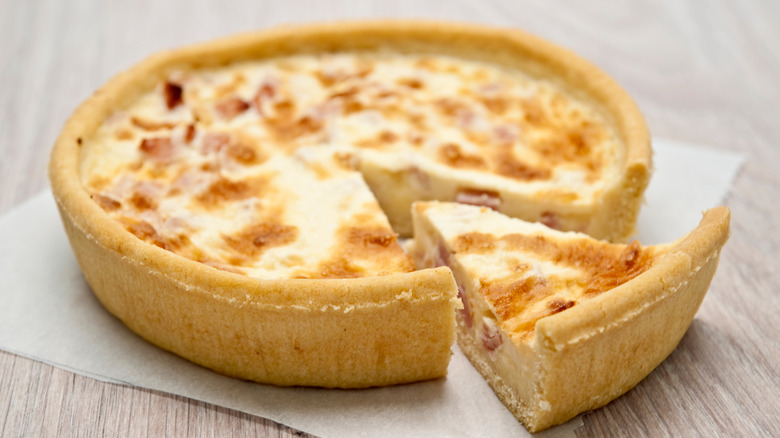12 Tips You Need To Know Before Freezing Eggs
Just like milk, berries, and raw meat, eggs are usually considered a refrigerator staple — so much so that many fridge models come equipped with built-in egg trays. But here's the part where we ask you to forget everything you know about proper egg storage. That's right, it's time to challenge the status quo and explore the unexpected world of freezing eggs. Whether you're facing an excess of leftover egg yolks post-angel food cake or a surplus of quiche slices, freezing leftover eggs extends their shelf life from a mere few days or weeks to an impressive span of months.
Now, before you start cramming eggs between popsicle boxes and TV dinners, there are a few things to learn. From testing eggs for freshness to removing the shell, we'll crack open all the need-to-know egg-freezing tips. We'll also share best practices for storing, thawing, and reheating eggs, ensuring that you don't waste a single yolk or scramble.
1. Test eggs for freshness before freezing them
Before you toss those eggs into the freezer, a crucial step awaits — ensuring their freshness. Neglect this step and you risk wasting precious freezer space with eggs better suited for the trash can. Fortunately, determining the freshness of eggs is a breeze. For those with pasteurized or store-bought eggs, a quick glance at the expiration date on the carton is all it takes. Freeze the eggs before this date, and you're good to go.
But what do you do if you already tossed the container, the expiration date has passed, or you're dealing with farm-fresh eggs? Fear not — the egg-in-water test will reveal everything you need to know. Test your eggs by filling a glass or bowl with cold water. Drop one egg in at a time and observe what happens. A fresh egg will sink to the bottom and lie flat, signaling its readiness for freezing. If it sinks but stands on one end, it's still edible but not as fresh. It's freezable, but not the ideal candidate. Lastly, if the egg floats, throw it out.
2. Remove the shell before freezing raw eggs
Freezing raw eggs can be a game-changer, but there's a catch — leaving them in their shells is a no-go. The liquid in the egg expands during freezing, exerting pressure on the shell and often leading to a messy outcome. Broken shells not only leave the eggs unusable but also make for an unpleasant freezer cleanup.
But cracking eggs before freezing isn't just about avoiding a kitchen fiasco. Rather, it's about food safety. According to the United States Department of Agriculture (USDA), eggshell exteriors aren't the most sanitary item in your kitchen. Despite strict washing and sanitizing procedures, eggshells may still contain salmonella enteritidis, a bacteria linked to foodborne illness. If the egg's interior comes into contact with the exterior shell during freezing, you open the door to consuming this harmful bacteria.
However, if you accidentally freeze eggs in their shells and the shells remain intact, the USDA offers a lifeline. Technically, you can still eat them. Just keep them frozen until needed and thaw overnight in the refrigerator. The agency suggests opting for hard cooking in such cases. That's because frozen yolks take on a thick, syrupy consistency, making it nearly impossible to blend them with egg whites or other ingredients.
3. An ice cube tray is your ally
Whether you've just whipped up a massive batch of lemony hollandaise sauce, a family-sized portion of crème brûlée, or another yolk-laden dish, you find yourself left with a load of leftover egg whites. While you know they'll come in handy for glazing bread or whipping up meringue in the future, the uncertainty of when that will be leaves you pondering the best storage solution. Stashing them in the refrigerator is an option, but with just four days of freshness, you won't have time to enjoy the treats you've already made.
Rather than succumbing to a baking-induced frenzy, consider the alternative: freezing egg whites. Believe it or not, egg whites will stay fresh for up to one year in the freezer. Using an ice cube tray is by far the easiest, most convenient solution we've found when it comes to freezing egg whites. Just place one egg white per slot and freeze. Once solid, transfer the cubes into a freezer-safe baggie. Don't forget to label it with the freeze date for easy reference. When the time comes to use them, thaw as many cubes as needed overnight in the refrigerator before incorporating them into your culinary creations.
4. Salt or sugar protects frozen egg yolks
While egg whites freeze effortlessly, transitioning from frozen cubes to egg white omelets without missing a beat, it's a different story when it comes to egg yolks. Their texture undergoes a significant transformation, shifting from smooth and creamy to syrupy or even gelatinous when frozen. In some cases, thawed frozen egg yolks become so firm that you can cut them with a knife, rendering them unusable in dishes like scrambled eggs or birthday cake. Even worse, once the texture has changed, there's no going back.
But it's not all doom and gloom. Thankfully, it's fairly easy to prepare an egg yolk for freezing. Here's the trick: whisk ¼ cup of egg yolks (about four yolks) with either ⅛ teaspoon of salt (for savory dishes) or 1½ teaspoons of sugar (for sweet dishes). Pour the mixture into a container with a snug lid, ensuring you label the number of yolks, the date, and whether you added salt or sugar. Freeze for up to four months, then thaw overnight in the refrigerator. While the texture won't be an exact match to its pre-freeze state, this technique ensures you can still make the most of your frozen egg yolks.
5. Leave scrambled eggs slightly runny before freezing
Up to this point, our focus has centered on freezing raw eggs, but what if you find yourself with extra scrambled eggs after a leisurely Sunday brunch? Or perhaps you're aiming to streamline your breakfast routine by preparing scrambled eggs in advance for hectic mornings? The good news is that scrambled eggs freeze remarkably well, retaining both their flavor and texture upon thawing.
However, these results aren't a stroke of luck. Instead, they hinge on meticulous preparation. While this may pose a challenge with leftover, already-cooked brunch eggs, it's easy to implement this trick when meal prepping. The key lies in shortening the cooking time of your scrambled eggs. Instead of scrambling them until firm, leave them slightly runny. This consistency won't look appetizing now, but it's perfect for freezing. By undercooking the eggs, you ensure they won't turn rubbery upon reheating, preserving their deliciousness for a convenient breakfast solution.
6. Not all parts freeze well
Eggs stand as true culinary powerhouses, with their unique composition allowing them to seamlessly play multiple roles in the kitchen. Their chameleon-like ability to take on various forms — whether poached, fried, or scrambled — renders them a versatile choice for any mealtime. However, even culinary superheroes like eggs have their kryptonite. While raw egg whites, cooked egg yolks, and breakfast casseroles freeze without a hitch, the same can't be said for cooked egg whites or whole hard- or soft-boiled eggs.
Once frozen, egg whites, whether attached to a yolk or on their own, become tough and rubbery. That's because they lack enough texture-preserving fat to keep them in shape. When thawed, they have a notably chewy texture that's far from appetizing. Adding to the challenge, frozen cooked egg whites release water upon thawing, leaving unsightly puddles in their wake. So, rather than fighting the natural order of things, it's best to eat egg whites and boiled eggs fresh and leave the freezing to the other parts.
7. Let eggs cool before freezing
Unless you're a newcomer to the world of freezing leftovers, you're probably aware that transferring a piping hot dish directly from the stove to the freezer is strictly verboten — you've got to give it some time to cool down to room temperature first. And even if you're familiar with this step, the underlying reason might not be as apparent. The crucial practice of allowing hot dishes, whether it's a tempting quiche lorraine, a savory cheesy bacon egg bake, or a wholesome spinach frittata, to sit out on the counter comes down to one fundamental concern: food safety.
When warm or hot food goes straight into the freezer, it elevates the interior temperature of the appliance. Predictably, this has a domino effect on the temperature of other frozen items. Now, you might wonder, what's the harm in a bit of thawing? The issue isn't so much thawing, but rather the temperature danger zone, a span of 40 to 140 F (per the U.S. Food and Drug Administration). Within this range, bacteria multiply like rabbits in springtime, posing a significant risk to the safety of your food items. To steer clear of potential foodborne illnesses, keep your egg dishes out of the freezer until they're cool to the touch.
8. Know your ratios
Amidst your newfound enthusiasm for freezing eggs, there's a common pitfall you'll want to sidestep. What might that be, you wonder? It involves freezing a batch of egg whites or yolks without a clear idea of the quantities you've stashed away. While it might seem like a minor inconvenience at first glance, it has the potential to turn a delightful afternoon of baking into a hair-pulling misadventure. Fear not, though — there's a simple solution to steer clear of this culinary calamity: proper portioning and a grasp of your ratios.
When it comes to portioning eggs, consider using either an ice cube tray or a muffin tin (a technique endorsed by Julia Child). Each slot of an ice cube tray accommodates one egg white, while a single muffin hole conveniently stores about two. Beyond that, understanding your ratios proves to be an invaluable tool. Here's what you need to know: approximately three tablespoons of thawed whole egg equate to one fresh egg, two tablespoons of thawed egg whites equal one large fresh egg white, and one tablespoon of thawed egg yolk equals one large fresh egg yolk.
9. Store frozen scrambled eggs in single-serving containers
Unlike some of the more rigid rules on this list, consider this tip more of a helpful suggestion than an absolute necessity. In other words, skipping it won't compromise the safety of your eggs or result in any disastrous outcomes. However, the sheer convenience it brings to the table makes it worth mentioning. The golden nugget of advice here revolves around storing frozen scrambled eggs in single-serving containers for freezing (just make sure to let them cool down before tucking them away). Depending on what you have on hand, opt for either resealable freezer-safe plastic bags or petite containers.
This nifty trick not only contributes to a more organized freezer but also eliminates any guesswork when it comes to portion sizes during mealtime. You thaw precisely what you need, avoiding the common pitfall of dealing with leftover leftovers. When the time comes to indulge, simply transfer a single-serving bag to the fridge overnight, then take your pick between microwaving for a quick fix or oven-heating for a thoroughly satisfying meal.
10. Use them up quickly
While it's undeniable that frozen eggs boast a longer lifespan compared to their refrigerated counterparts, that doesn't grant you the liberty to toss them into the depths of the icebox and leave them to be forgotten. Much like the recommended three-month shelf life for oily fish and the six-month time limit for frozen fruit, paying attention to how long eggs have been in the deep freeze is crucial. This diligence ensures that they maintain their delicious flavor and avoid adopting any undesirable textures.
A smart approach to keeping tabs on this is to label the freeze date on bags and containers before storing them. But a date with no guidance is useless, so let's break down some timelines to keep in mind. Raw whole eggs and egg whites maintain their quality when frozen for up to one year. When it comes to cooked egg dishes such as a slow cooker breakfast casserole, roasted vegetable quiche, or crustless tomato pie, your best bet is to consume them within two to three months in order to savor the peak of their freshness.
11. Thaw with care
Understanding the intricacies of egg freezing is a great starting point, but the real test comes when you need to thaw them correctly. Just as defrosting meat and seafood demands careful handling, the same level of consideration applies to the process of thawing eggs. Perhaps the most important thing to keep in mind is that you need to plan ahead. Indeed, the safest method involves leaving frozen eggs in the refrigerator overnight. This gradual thawing process ensures a steady rise in temperature, completely sidestepping the temperature danger zone and the potential foodborne illnesses associated with it (via Healthline).
With that said, we know it's impossible to predict when a cheese omelet craving will appear. When you're in a rush, you can expedite the thawing process by placing the eggs (still in a sealed container) under cold running water for several minutes. It's important to avoid hot water, as it could prematurely cook the eggs. Once the eggs have returned to their original form, use them as you normally would.
12. Frozen eggs are best in thoroughly cooked dishes
Embracing the perks of extended shelf life, minimizing food waste, and enjoying the convenience of egg access on-demand are all compelling reasons to explore freezing eggs. However, it's important to acknowledge that even when thawed correctly, eggs pose a potential risk for foodborne illnesses, particularly salmonella, as emphasized by the Centers for Disease Control and Prevention (CDC). In light of this, our recommendation is to consume only defrosted eggs that have been thoroughly cooked.
While this might be disappointing news for all of the poached egg and eggs Benedict enthusiasts out there, try to see this tip not as a limitation but instead as a precaution. Indeed, you can use thawed whole eggs to whip up Gordan Ramsay's scrambled eggs or craft egg white breakfast cups from thawed egg whites. Working with an already-cooked egg dish? Just make sure to give it a good zap in the microwave before serving. In all three cases, the heat generated by the cooking process should be enough to ward off any harmful bacteria. Still, if you have any doubts, use a food thermometer to measure the internal temperature. According to the CDC, egg dishes containing meat or poultry should reach at least 165 F; those without should be heated to 160 F.
Static Media owns and operates Tasting Table and Mashed.
